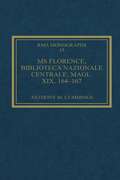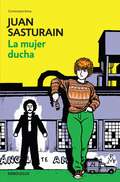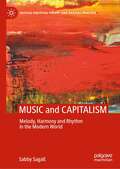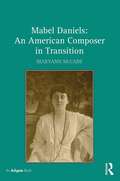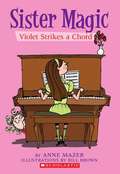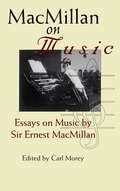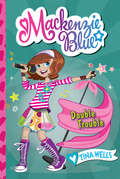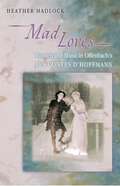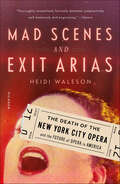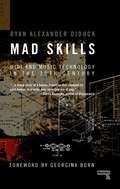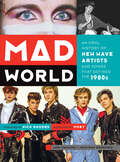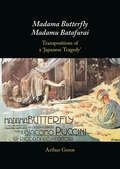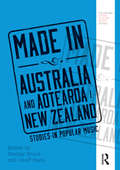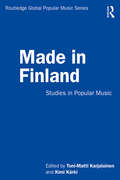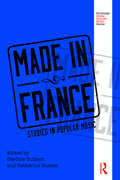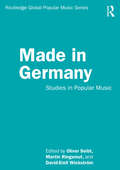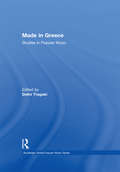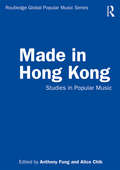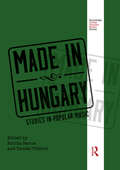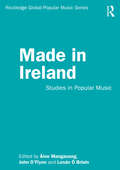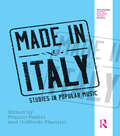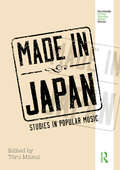- Table View
- List View
MS Florence, Biblioteca Nazionale Centrale, Magl. XIX, 164-167 (Royal Musical Association Monographs)
by AnthonyM. CummingsManuscript Florence, Biblioteca Nazionale Centrale, Magliabechiana XIX, 164-167 (FlorBN Magl. 164-7) has been the subject of considerable scholarly attention. The prevailing assumption had been that it was a Florentine source of the early sixteenth century. More recently, it has been argued that its provenance is not as easily determined as it first appears, and that there are Roman connections suggested by one of its codicological features. This monograph provides as full a bibliographical and codicological report on FlorBN Magl. 164-7 as is currently possible. Such evidence suggests that the earlier thesis is more likely to be correct: the manuscript was copied in Florence c.1520. After a review of the evidence for provenance and date, the repertory of the manuscript is placed in its historical and cultural context. Florence of the early sixteenth century is shown to have an organized cultural life that was characterized by the activities of such institutions as the Sacred Academy of the Medici, the famous group that met in the garden of the Rucellai, and others. FlorBN Magl. 164-7 is an exceedingly interesting and important source; an eclectic repository not only of compositionally advanced settings of Petrarchan verse by Rucellai-group intimate Bernardo Pisano but also of sharply contrasting works, popular in character. It is almost a manifesto of the sensibilities of preeminent Florentine cultural figures of the sort who frequented the garden of the Rucellai and as such is a revealing document of Florentine musical taste during those crucial years that witnessed the emergence of the new secular genre we know as the Italian madrigal.
MUJER DUCHA, LA (EBOOK)
by Juan SasturainUn libro de relatos de Juan Sasturain es una galería de mundos y paisajes bien definidos y diferenciados, siempre memorables. En obras de esta índole, el lector, atento al rastro de cada personaje, convierte la evasión en encantamiento, el gusto en adicción. Es difícil salir ileso de estas historias que nos permiten revivir emociones sumergidas en la nostalgia: los mitos del fútbol tal como eran en la infancia, imaginar de nuevo el pasado remoto, los caballeros andantes y sus proezas épicas. Todo eso y más ocurre en La mujer ducha, aunque el elogio del libro no pueda siquiera rozar la experiencia de leerlo.
MUSIC and CAPITALISM: Melody, Harmony and Rhythm in the Modern World (Critical Political Theory and Radical Practice)
by Sabby SagallThis book argues that the need for music, and the ability to produce and enjoy it, is an essential element in human nature. Every society in history has produced some characteristic style of music. Music, like the other arts, tells us truths about the world through its impact on our emotional life. There is a structural correspondence between society and music. The emergence of 'modern art music' and its stylistic changes since the rise of capitalist social relations reflect the development of capitalist society since the decline of European feudalism. The leading composers of the different eras expressed in music the aspirations of the dominant or aspiring social classes. Changes in musical style not only reflect but in turn help to shape changes in society. This book analyses the stylistic changes in music from the emergence of ‘tonality’ in the late seventeenth century until the Second World War.
Mabel Daniels: An American Composer In Transition
by Maryann McCabeMabel Daniels (1877–1971): An American Composer in Transition assesses Daniels within the context of American music of the first half of the twentieth century. Daniels wrote fresh sounding works that were performed by renowned orchestras and ensembles during her lifetime but her works have only recently begun to be performed again. The book explains why works by Daniels and other women composers fell out of favor and argues for their performance today. This study of Daniels’s life and works evinces transition in women’s roles in composition, the professionalization of women composers, and the role that Daniels played in the institutionalization of American art music. Daniels’s dual role as a patron-composer is unique and expressive of her transitional status.
Mabel Strikes a Chord (Sister Magic #4)
by Anne MazerThe family has gotten a piano that Mabel loves to play. When five-year-old Violet learns Mabel is going to play in a concert, she wants to join in.
MacMillan on Music: Essays by Sir Ernest MacMillan
by Ernest Macmillan Carl MoreyIn addition to his activities as conductor, administrator, educator, composer, and organist, Sir Ernest MacMillan (1893-1973) found time to write more than one hundred essays and lectures on music. Always ready to use his enormous prestige to further the causes of music, MacMillan took every opportunity to admonish Canadians to develop our own composers, to honour our own performers, to educate our children musically, and to offer opportunities for all to hear, learn about, and enjoy great music.This selection of twenty essays and lectures covers the period from 1928 to 1964, and ranges over the gamut of MacMillan’s life and interests: the cause of the Canadian composer; music education for adults as well as children; critical reviews; his early years as an organist; internment in a German prison camp during the First World War; Shakespeare and music; church music; and the lighter side in two humorous send-ups of academic lectures on Bach and Wagner. Here is a panorama of music over thirty-five years at mid-century, through the eyes of one of Canada’s most brilliant and all-embracing musicians.
Mackenzie Blue #5: Double Trouble
by Tina Wells Michael SegawaMackenzie Blue is a star! Or she will be . . . as soon as she gets the part of an aspiring singer on a new TV pilot! But juggling auditions and the rest of her life turns out to be harder than Zee thought. Zee's friends are helping her hold everything together. But Zee doesn't like having to bail on plans--and her friends--to run to another audition. Is being a star worth it?Fans of the Dork Diaries will snap up the fifth book in this tween illustrated series about a twelve-year-old girl trying to survive middle school.
Mackenzie Blue: Mixed Messages
by Tina WellsMackenzie Blue and her crew are plugged in! Zee and her band, The Beans, are getting ready for their biggest show yet! Everyone's talking about it online at Bluetopia-the coolest social-networking site ever. Top three reasons that Bluetopia is the best: I can keep all my thoughts safe in a private blog, and I won't have to worry about anyone stealing my diary (finally)! The Beans have a huge show coming up, and we can make sure everyone knows about it! Jasper (my best guy friend) is in the spotlight for creating the site. He's so talented-he deserves it.
Mad Loves: Women and Music in Offenbach's Les Contes d'Hoffmann (Princeton Studies in Opera #16)
by Heather HadlockIn a lively exploration of Jacques Offenbach's final masterpiece, Heather Hadlock shows how Les Contes d'Hoffmann summed up not only the composer's career but also a century of Romantic culture. A strange fusion of irony and profundity, frivolity and nightmare, the opera unfolds as a series of dreamlike episodes, peopled by such archetypes as the Poet, the Beautiful Dying Girl, the Automaton, the Courtesan, and the Mesmerist. Hadlock shows how these episodes comprise a collective unconscious. Her analyses touch on topics ranging from the self-reflexive style of the protagonist and the music, to parallels between nineteenth-century discourses of theater and medical science, to fascination with the hysterical female subject. Les Contes d'Hoffmann is also examined as both a continuation and a retraction of tendencies in Offenbach's earlier operettas and opéra-comiques. Hadlock investigates the political climate of the 1870s that influenced the composer's vision and the reception of his last work. Drawing upon insights from feminist, literary, and cultural theory, she considers how the opera's music and libretto took shape within a complex literary and theatrical tradition. Finally, Hadlock ponders the enigmas posed by the score of this unfinished opera, which has been completed many times and by many different hands since its composer's death shortly before the premiere in 1881. In this book, the "mad loves" that drive Les Contes d'Hoffmann--a poet's love, a daughter's love, erotic love, and fatal attraction to music--become figures for the fascination exercised by opera itself.
Mad Scenes and Exit Arias: The Death of the New York City Opera and the Future of Opera in America
by Heidi WalesonFrom the Wall Street Journal’s opera critic, a history of how and why the New York City Opera went bankrupt—and what it means for the future of the arts.In October 2013, the arts world was rocked by the news that the New York City Opera—“the people’s opera”—had finally succumbed to financial hardship after 70 years in operation. The company had been a fixture on the national opera scene—as the populist antithesis of the grand Metropolitan Opera, a nurturing home for young American talent, and a place where new, lively ideas shook up a venerable art form. But NYCO’s demise represented more than the loss of a cherished organization: it was a harbinger of massive upheaval in the performing arts—and a warning about how cultural institutions would need to change in order to survive.Drawing on extensive research and reporting, Heidi Waleson, one of the foremost American opera critics, recounts the history of this scrappy company and reveals how, from the beginning, it precariously balanced an ambitious artistic program on fragile financial supports. Waleson also looks forward and considers some better-managed, more visionary opera companies that have taken City Opera’s lessons to heart.Above all, Mad Scenes and Exit Arias is a story of money, ego, changes in institutional identity, competing forces of populism and elitism, and the ongoing debate about the role of the arts in society. It serves as a detailed case study not only for an American arts organization, but also for the sustainability and management of nonprofit organizations across the country.“An intricate whodunit that seeks to find out who murdered the New York City Opera. . . . Waleson gives us a vivid description of each death-defying crisis and a sharp portrait of the ever-changing cast of would-be saviors who somehow always failed in their mission.” —The New York Times Book Review“Thoroughly researched, factually detailed, judgmentally well-balanced, and engrossing.” —Opera“Waleson’s in-depth study illustrates the challenges City Opera—and other opera houses—face in the 21st century as they seek to preserve tradition and innovate.” —Publishers Weekly“A thorough recounting of the tumultuous history of the New York City Opera [and] a cleareyed examination of the economic fragility of cultural institutions.” —Kirkus Reviews
Mad Skills: MIDI and Music Technology in the Twentieth Century
by Ryan DiduckA cultural history of MIDI (the Musical Instrument Digital Interface), one of the most revolutionary and transformative technologies in the history of music.A history of electronic music that goes way beyond the Moog. Part rigorous history, part insightful commentary, and part memoir, Mad Skills tells the story behind MIDI, aka the Musical Instrument Digital Interface, through the twentieth century's kaleidoscopic lens. Guiding us across one hundred years of musical instruments, and the music made with them, Mad Skills recounts the technical and creative innovations that led to the making of the most vital, long-standing, ubiquitous, and yet invisible music technology of our time.
Mad World: An Oral History of New Wave Artists and Songs That Defined the 1980s
by Jonathan Bernstein Lori MajewskiA &“hugely entertaining&” history of the 1980s New Wave music scene told through new interviews with its biggest artists (Rolling Stone). Mad World is a compelling oral history that celebrates the New Wave music phenomenon of the 1980s via new interviews with 35 of the most notable artists of the period. Each chapter begins with a discussion of their most popular song and leads to stories of their history and place in the scene, ultimately painting a vivid picture of this colorful, idiosyncratic time. Mixtape suggestions, fashion sidebars, and quotes from famous contemporary admirers help fill out the fun. Participants include members of Duran Duran, New Order, The Smiths, Tears for Fears, Adam Ant, Echo, and the Bunnymen, Devo, ABC, Spandau Ballet, A Flock of Seagulls, Thompson Twins, INXS, and more. &“One addictive chapter after another.&” —Rob Sheffield, author of Talking to Girls About Duran Duran &“Tells the tale of some of the decade&’s most unforgettable songs . . . in fascinating detail, letting the architects of these memorable records shine a light on how the sound of a generation came to be.&” —The Hollywood Reporter &“The new wave era is often dismissed for its one-hit wonders and silly haircuts, but [Mad World] examines the period with a great deal of love and reverence.&” —Buzzfeed &“A really informative and insightful read.&” —People
Madama Butterfly/Madamu Batafurai: Transpositions of a 'Japanese Tragedy'
by Arthur GroosPuccini's famous but controversial Madama Butterfly reflects a practice of 'temporary marriage' between Western men and Japanese women in nineteenth-century treaty ports. Groos' book identifies the plot's origin in an eye-witness account and traces its transmission via John Luther Long's short story and David Belasco's play. Archival sources, many unpublished, reveal how Puccini and his librettists imbued the opera with differing constructions of the action and its heroine. Groos's analysis suggests how they constructed a 'contemporary' music-drama with multiple possibilities for interpreting the misalliance between a callous American naval officer and an impoverished fifteen-year-old geisha, providing a more complex understanding of the heroine's presumed 'marriage'. As an orientalizing tragedy with a racially inflected representation of Cio-Cio-San, the opera became a lightning rod for identity politics in Japan, while also stimulating decolonizing transpositions into indigenous theatre traditions such as Bunraku puppet theatre and Takarazuka musicals.
Made In Hollywood: All Access with the Go-Go’s
by Gina SchockThe Go-Go&’s were the first all-female rock group in history to write their own songs, play their own instruments, and reach the top of the Billboard charts with their #1 album, Beauty and the Beat. Made In Hollywood is drummer Gina Schock&’s personal account of the band, which includes a treasure trove of photographs and memorabilia collected over the course of her 40-year career.The Go-Go&’s debut album, Beauty and the Beat, rose to the top of the charts in 1981 and their hit songs "We Got the Beat", "Our Lips Are Sealed", &“Vacation&”, and "Head Over Heels" (to name a few) served as a soundtrack to our lives in the &‘80s.Now, after the release of their Critics Choice Award-winning Showtime documentary, and in anticipation of their forthcoming induction into the Rock & Roll Hall of Fame and their 2021 West Coast shows, Gina takes fans behind the scenes for a rare look at her personal images documenting the band's wild journey to the heights of fame and stardom. Featuring posters, photographs, Polaroids, and other memorabilia from her archives, Made In Hollywood also includes stories from each member of the Go-Go&’s, along with other cultural luminaries like Kate Pierson, Jodie Foster, Dave Stewart, Martha Quinn, and Paul Reubens.With a style as bold and distinctive as any Go-Go&’s album, Made In Hollywood is the perfect tribute to one of the world's most iconic groups.
Made in Australia and Aotearoa/New Zealand: Studies in Popular Music (Routledge Global Popular Music Series)
by Geoff Stahl Shelley BruntMade in Australia and Aotearoa/New Zealand: Studies in Popular Music serves as a comprehensive and thorough introduction to the history, sociology, and musicology of twentieth-century popular music of Australia and Aotearoa/New Zealand. The volume consists of chapters by leading scholars of Australian and Aotearoan/New Zealand music, and covers the major figures, styles, and social contexts of pop music in Australia and Aotearoa/New Zealand. Each chapter provides adequate context so readers understand why the figure or genre under discussion is of lasting significance to Australian or Aotearoan/New Zealand popular music. The book first presents a general description of the history and background of popular music in these countries, followed by chapters that are organized into thematic sections: Place-Making and Music-Making; Rethinking the Musical Event; Musical Transformations: Decline and Renewal; and Global Sounds, Local Identity.
Made in Brazil: Studies in Popular Music (Routledge Global Popular Music Series)
by Martha Tupinamba de Ulhoa Cláudia Azevedo Felipe TrottaMade in Brazil: Studies in Popular Music serves as a comprehensive and thorough introduction to the history, sociology, and musicology of twentieth-century Brazilian popular music. The volume consists of essays by scholars of Brazilian music, and covers the major figures, styles, and social contexts of pop music in Brazil. Each essay provides adequate context so readers understand why the figure or genre under discussion is of lasting significance to Brazilian popular music. The book first presents a general description of the history and background of popular music in Brazil, followed by essays that are organized into thematic sections: Samba and Choro; History, Memory, and Representations; Scenes and Artists; and Music, Market and New Media.
Made in Finland: Studies in Popular Music (Routledge Global Popular Music Series)
by Toni-Matti KarjalainenMade in Finland: Studies in Popular Music serves as a comprehensive and thorough introduction to the history, culture, and musicology of twentieth and twenty-first century popular music in Finland. The volume consists of essays by leading scholars in the field, and covers the major figures, styles, and social contexts of popular music in Finland. Each essay provides adequate context so readers understand why the figure or genre under discussion is of lasting significance. The book is organized into five thematic sections: Emerging Foundations of Popular Music in Finland; Environments, Borderlines, Minorities; Transnationalisms; Sounds from the Underground; and Redefining Finnishness.
Made in France: Studies in Popular Music (Routledge Global Popular Music Series)
by Gérôme Guibert Catherine RudentMade in France: Studies in Popular Music serves as a comprehensive introduction to the history, sociology, and musicology of contemporary French popular music. The volume consists of essays by scholars of French popular music, and covers the major figures, styles, and social contexts of pop music in France. The book first presents a general description of the history and background of popular music in France, followed by essays that are organized into thematic sections: The Mutations of French Popular Music During the "Trente Glorieuses"; Politicising Popular Music; Assimilation, Appropriation, French Specificity; and From Digital Stakes to Cultural Heritage: French Contemporary Topics. Contributors: Christian Béthune Juliette Dalbavie Gérôme Guibert Fabien Hein Olivier Julien Marc Kaiser Barbara Lebrun David Looseley Stéphanie Molinero Anne Petiau Cécile Prévost-Thomas Vincent Rouzé Catherine Rudent Matthieu Saladin Jedediah Sklower Raphaël Suire Florence Tamagne
Made in Germany: Studies in Popular Music (Routledge Global Popular Music Series)
by Oliver SeibtMade in Germany: Studies in Popular Music serves as a comprehensive introduction to the history, sociology, and musicology of contemporary German popular music. Each essay, written by a leading scholar of German music, covers the major figures, styles, and social contexts of pop music in Germany and provides adequate context so readers understand why the figure or genre under discussion is of lasting significance. The book first presents a general description of the history and background of popular music in Germany, followed by essays organized into thematic sections: Historical Spotlights; Globally German; Also "Made in Germany"; Explicitly German; and Reluctantly German.
Made in Greece: Studies in Popular Music (Routledge Global Popular Music Series)
by Dafni TragakiMade in Greece: Studies in Popular Music serves as a comprehensive and thorough introduction to the history, sociology, and musicology of contemporary Greek popular music. Each essay covers the major figures, styles, and social contexts of pop music in Greece, first presenting a general description of the history and background of popular music in Greece, followed by essays, written by leading scholars of Greek music, that are organized into thematic sections: Hugely Popular, Art-song Trajectories, Greekness beyond Greekness, Counter Stories, and Present Musical Pasts.
Made in Hong Kong: Studies in Popular Music (Routledge Global Popular Music Series)
by Anthony Fung Alice ChikMade in Hong Kong: Studies in Popular Music serves as a comprehensive and thorough introduction to the history, sociology, and musicology of twentieth- and twenty-first century popular music in Hong Kong. The volume consists of essays by leading scholars in the field, and it covers the major figures, styles, and social contexts of popular music in Hong Kong. Each essay provides adequate context to allow readers to understand why the figure or genre under discussion is of lasting significance. The book is organized into four thematic sections: Cantopop, History and Legacy; Genres, Format, and Identity; Significant Artists; and Contemporary Cantopop.
Made in Hungary: Studies in Popular Music (Routledge Global Popular Music Series)
by Emília Barna Tamás TófalvyEmília Barna is Assistant Professor at the Budapest University of Technology and Economics. She is a founding member and Chair of IASPM Hungary, editor of Zenei Hálózatok Folyóirat (Music Networks Journal), and Advisory Board Member of IASPM@Journal. Tamás Tófalvy is Assistant Professor at the Budapest University of Technology and Economics. He was the founding Chair and is the current Vice-Chair of IASPM Hungary.
Made in Ireland: Studies in Popular Music (Routledge Global Popular Music Series)
by John O'Flynn Áine Mangaoang Lonán Ó BriainMade in Ireland: Studies in Popular Music serves as a comprehensive and thorough introduction to the history, sociology and musicology of 20th- and 21st-century Irish popular music. The volume consists of essays by leading scholars in the field and covers the major figures, styles and social contexts of popular music in Ireland. Each essay provides adequate context so readers understand why the figure or genre under discussion is of lasting significance to Irish popular music. The book is organized into three thematic sections: Music Industries and Historiographies, Roots and Routes and Scenes and Networks. The volume also includes a coda by Gerry Smyth, one of the most published authors on Irish popular music.
Made in Italy: Studies in Popular Music (Routledge Global Popular Music Series)
by Franco Fabbri Goffredo PlastinoMade in Italy serves as a comprehensive and rigorous introduction to the history, sociology, and musicology of contemporary Italian popular music. Each essay, written by a leading scholar of Italian music, covers the major figures, styles, and social contexts of pop music in Italy and provides adequate context so readers understand why the figure or genre under discussion is of lasting significance to Italian popular music. The book first presents a general description of the history and background of popular music, followed by essays organized into thematic sections: Themes; Singer-Songwriters; and Stories.
Made in Japan: Studies in Popular Music (Routledge Global Popular Music Series)
by Toru MitsuiMade in Japan serves as a comprehensive and rigorous introduction to the history, sociology, and musicology of contemporary Japanese popular music. Each essay, written by a leading scholar of Japanese music, covers the major figures, styles, and social contexts of pop music in Japan and provides adequate context so readers understand why the figure or genre under discussion is of lasting significance. The book first presents a general description of the history and background of popular music, followed by essays organized into thematic sections: Putting Japanese Popular Music in Perspective; Rockin’ Japan; and Japanese Popular Music and Visual Arts.
